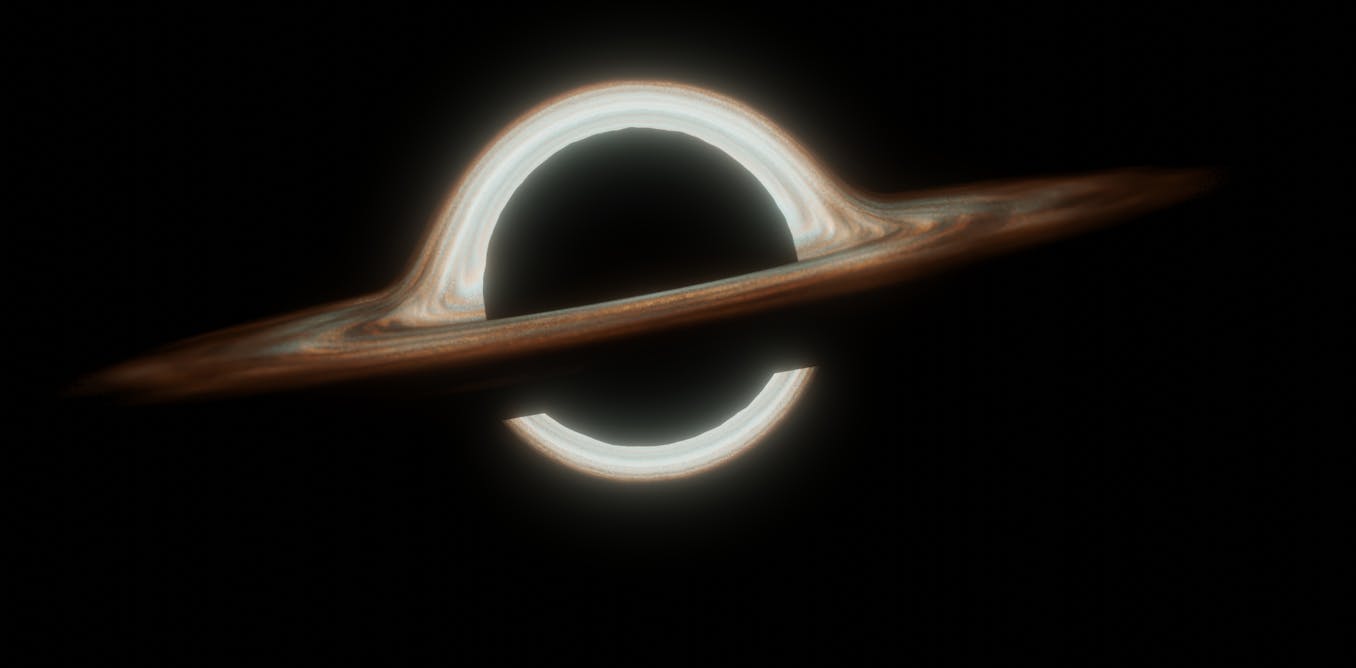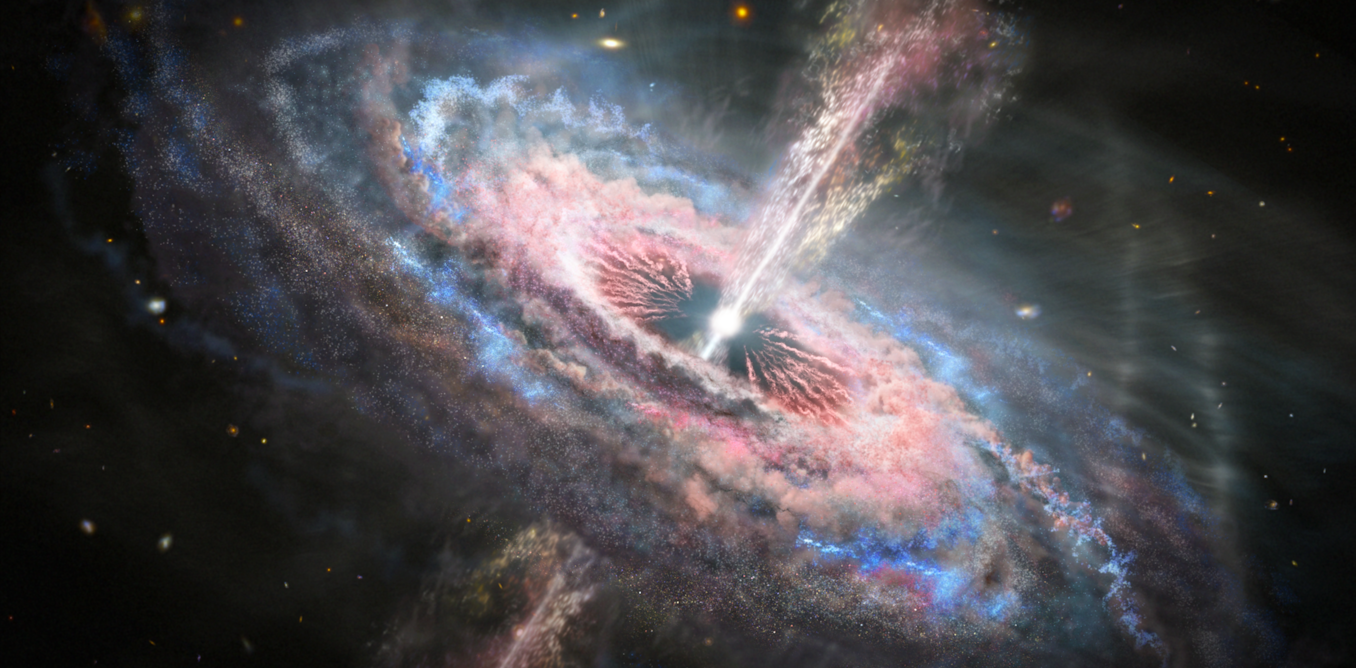The brightest object ever observed in the night sky is a black hole that’s growing by the equivalent of one Sun a day
The extreme object could tell us more about the environment around black holes.
Feb. 21, 2024 • 7 min • Source
A new study published in Nature Astronomy describes the most luminous object ever observed by astronomers. It is a black hole with a mass of 17 billion Suns, swallowing a greater amount of mass than the Sun every single day.
It has been known about for several decades, but since it is so bright, astronomers assumed it must be a nearby star. Only recent observations revealed its extreme distance and luminosity.
The object has been dubbed J0529-4351. This name simply refers to its coordinates on the celestial sphere – a way of projecting the objects in the sky onto the inside of a sphere. It is a type of object called a quasar .
The physical nature of quasars was initially unknown. But in 1963, the visible light from a quasar called 3C 273 was split into all its wavelengths (known as its spectrum). This showed that it was located nearly 2 billion light years away.
Given how bright 3C 273 appears to us, and how far away it is, it must be extremely luminous – a term in astronomy that refers to the amount of light emitted by an object in a unit of time. The only known power source for such extreme luminosity was through material falling into a supermassive black hole . Quasars are therefore the most actively growing black holes in the universe.
Power source
Supermassive black holes often sit at the centres of galaxies. As with all quasars, J0529-4351 is powered by material, mostly super-heated hydrogen and helium gas, falling into its black hole from the surrounding galaxy.
Roughly one times the Sun’s mass is falling into this black hole every day. Exactly how so much gas can be channelled into the centre of galaxies to increase the mass of black holes is an unanswered question in astrophysics.
At the galaxy’s centre, the gas forms into a thin disk shape. The properties of viscosity (resistance to the flow of matter in space) and friction in the thin disk help heat the gas to tens of thousands of degrees Celsius. This is hot enough to glow when viewed at ultraviolet and visible light wavelengths. It is that glow that we can observe from Earth.
At around 17 billion Suns in mass, J0529-4351 is not the most massive known black hole. One object, at the centre of the galaxy cluster Abell 1201, is equivalent to 30 billion Suns . However, we need to bear in mind that because of the time taken for light to travel across the vast distance between this object and Earth, we are witnessing it when the universe was only 1.5 billion years old. Its is now around 13.7 billion years old.
So this black hole must have been growing, or accreting, at this rate for a significant fraction of the age of the universe by the time it was observed. The authors believe the gas accretion by the black hole is happening close to the limit placed by the laws of physics. Faster accretion causes a more luminous disk of gas around the black hole which in turn can halt any more material falling in.
Story of the discovery
J0529-4351 has been known about for decades, but despite having an accretion disk of gas 15,000 times larger than our Solar System and occupying its own galaxy – which is probably close to the size of the Milky Way – it is so far away, it appears as a single point of light in our telescopes.
This means it is difficult to distinguish from the billions of stars in our own galaxy. To discover that it is in fact a distant, powerful, supermassive black hole required some more complex techniques. Firstly, astronomers collected light from the middle of the infrared waveband (light with much longer wavelengths than those we can see).
Stars and quasars look quite different to one another at those wavelengths. To confirm the observation, a spectrum was taken (much as it was with the quasar 3C 273), using the Australian National University’s 2.3 metre telescope at Siding Spring Observatory, New South Wales.
And, as with 3C 273, the spectrum revealed both the nature of the object and how far away it was – 12 billion light years. This highlighted how extreme its luminosity must be.
Detailed checks
Despite these measurements, a number of checks needed to be made to confirm the true luminosity of the quasar. Firstly, astronomers needed to make sure that the light had not been magnified by a source in the sky that was closer to Earth. Much like lenses used in spectacles or binoculars, galaxies can act as lenses. They are so dense that they can bend and magnify the light of more distant sources that are perfectly aligned behind them.
Data from the European Space Agency’s Gaia satellite, which has extremely precise measurements of J0529-4351’s position, was used to determine that J0529-4351 is truly a single non-lensed source of light in the sky. This is backed up by more detailed spectra taken with the European Southern Observatory’s Very Large Telescope (VLT) facility in Chile.
J0529-4351 is likely to become a very significant tool for the future study of quasars and black hole growth. The mass of black holes is a fundamental property but is very difficult to measure directly, as there is no standard set of weighing scales for such absurdly large, mysterious objects.
One technique is to measure the effect the black hole has on more diffuse gas orbiting it in large clouds, called the “broad line region”. This gas is revealed in the spectrum through wide “emission lines”, which are caused by electrons jumping between specific energy levels in the ionised gas.
The width of these lines is directly related to the mass of the black hole, but the calibration of this relationship is very poorly tested for the most luminous objects such as J0529-4351. However, because it is so physically large and so luminous, J0529-4351 will be observable by a new instrument being installed on the VLT, called Gravity+ .
This instrument will give a direct measurement of the black hole mass and calibrate the relationships used to estimate masses in other high-luminosity objects.
Philip Wiseman works at the University of Southampton and is funded by the Science and Technology Facilities Council.



